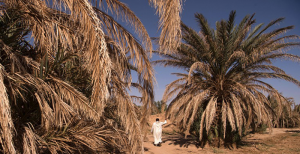
Residents of the Mahgreb region in Sahara desert are losing their local Oases as extreme temperatures and lower rainfall become the norm across the region. Global warming is pushing existing climate away from the equator toward the poles. Starting at the equator, a tropical death-zone has appeared wiping out mangroves, coral reefs and now desert oases. At the poles, polar bears and other polar animals are disappearing as temperate conditions establish themselves. Hybrid polar and grizzly bears are now commonplace. The process is accelerating as Arctic ice disappears and methane levels soar to 2,436 parts per billion, more than three times pre industrial levels.
A Drive To Save Saharan Oases As Climate Change Takes a Toll
From Morocco to Libya, the desert oases of the Sahara’s Maghreb region are disappearing as temperatures rise and rainfall decreases. Facing daunting odds, local residents are employing traditional water conservation techniques to try to save these ancient ecosystems.
Methane has just spiked at 2436 ppb
Methane levels over the Arctic Ocean were as high as 2436 parts per billion on the afternoon of December 5, 2016, with most rising from the water. Pre-industrial level was ~720 ppb and each molecule is 20 times more potent than C02. Add that up!
http://arctic-news.blogspot.com.au/2016/12/seafloor-methane.html
A degree by degree explanation of what will happen when the earth warms
At 2C temperature increase the hot European summer of 2003 will be the annual norm. Anything that could be called a heatwave thereafter will be of Saharan intensity. Even in average years, people will die of heat stress.
Beyond 2C billions of people will face an increasingly tough battle to survive. To find anything comparable we have to go back to the Pliocene 3m years ago. There were no continental glaciers in the northern hemisphere (trees grew in the Arctic), and sea levels were 25 metres higher than today’s. In this kind of heat, the death of the Amazon is as inevitable as the melting of Greenland.
Between 3 and 4C the summers get longer as soaring temperatures reduce forests to tinderwood and cities to boiling morgues. Temperatures in the Home Counties could reach 45C – the sort of climate experienced today in Marrakech. Droughts will put the south-east of England on the global list of water-stressed areas, with farmers competing against cities for dwindling supplies from rivers and reservoirs. Air-conditioning will be mandatory for anyone wanting to stay cool and the abandonment of the Mediterranean will send even more people north to overcrowded refuges in Scandinavia.
Between 4 and 5C it will be an entirely different planet. Ice sheets have vanished from both poles; rainforests have burnt up and turned to desert; the dry and lifeless Alps resemble the High Atlas; rising seas are scouring deep into continental interiors. Even in Canada and Siberia summers may be too hot for crops to be grown away from the coasts. When temperatures were at a similar level 55m years ago in the early Eocene, alligators were living in the Arctic.
Between 5 and 6C at the end of the Permian, 251m years ago, 95% of species were wiped out. That episode was the worst ever endured by life on Earth, the closest the planet has come to ending up a dead and desolate rock in space. On land, the only winners were fungi that flourished on dying trees and shrubs.
http://globalwarming.berrens.nl/globalwarming.htm

Arctic Warming at Least Twice as Fast as Rest of World
Much of this melt was almost certainly driven by the record warm Arctic temperatures seen during 2016. And according to NOAA, this year shattered all previous high marks for Arctic heat by a big margin — hitting 3.5C warmer than 1900. Overall, this rate of warming is at least twice as fast as the rest of the globe.
https://robertscribbler.com/2016/12/15/noaas-2016-report-card-the-arctic-is-shouting-change/
Change in the Arctic this year was unlike any ever seen, scientists say
The annual Arctic Report Card documented air and sea-surface temperatures are higher, sea ice is sparser and more fragile and ocean waters absorbing more carbon, thus changing their chemistry to more acidic levels, while warming tundra is now expelling more carbon than it is drawing in from the atmosphere.
